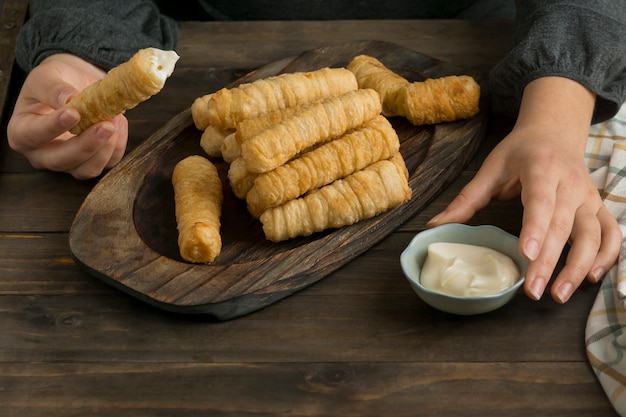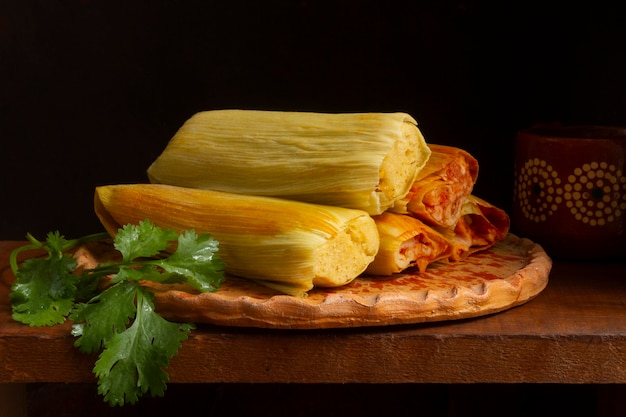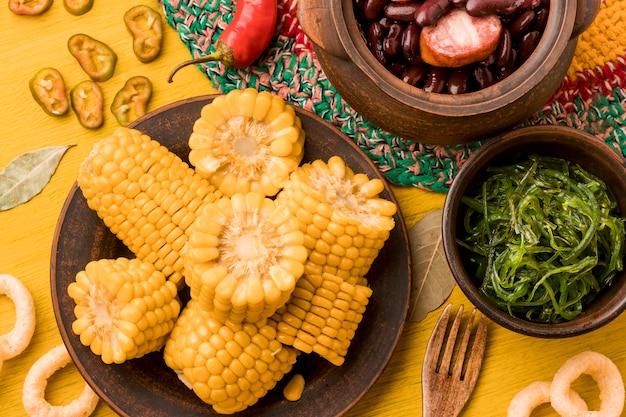The aroma of freshly steamed tamales is enough to make anyone's mouth water. These little bundles of joy, filled with savoury or sweet treasures and wrapped in corn husks or banana leaves, are a testament to the culinary artistry of generations. But let's face it, the cooking time can be a bit of a mystery, especially for the uninitiated. So, let's delve into the world of tamale cooking and unravel the secrets behind their perfect timing.
(Part 1) A World of Tamales: A culinary journey

Before we dive into the nitty-gritty of cooking times, let's embark on a culinary journey to understand the diverse world of tamales. Each region, each culture, has its own unique way of preparing these delightful treats. It's a culinary tapestry woven with the threads of history, tradition, and innovation.
From Ancient Mesoamerica to Modern Kitchens: A Story of Tamales
The origins of tamales can be traced back to ancient Mesoamerica, where the Mayans and Aztecs used corn, a staple food, to create these delectable parcels. They were not just a culinary delight but also a symbol of sustenance and cultural identity. Today, tamales have transcended borders and cultures, evolving into a global culinary treasure.
A World of Flavors: Exploring the Diversity of Tamales
The beauty of tamales lies in their versatility. From the hearty meat fillings of Mexican tamales to the sweet, fruity flavors of Guatemalan tamales, each region offers a unique interpretation of this culinary masterpiece.
- Mexican Tamales: The quintessential tamale, often filled with pork, chicken, or beef and wrapped in corn husks, representing the heart and soul of Mexican cuisine.
- Oaxacan Tamales: From the southern Mexican state of Oaxaca, these tamales are renowned for their vibrant mole sauces, often incorporating chicken, turkey, or even pork. The rich blend of spices and flavors creates a truly unforgettable culinary experience.
- Salvadoran Tamales: These tamales are a fusion of cultural influences, featuring rice, beans, and spices that reflect the country's rich culinary history. They're typically wrapped in banana leaves, adding another layer of flavor and texture.
- Guatemalan Tamales: These tamales are a testament to Guatemalan culinary traditions, often featuring a slightly sweeter masa dough and fillings like chicken, pork, or vegetables. They are a popular dish for special occasions and celebrations.
No matter where you go, tamales represent a shared culinary heritage, a testament to the ingenuity and creativity of human beings.
(Part 2) Understanding the Basics: Unraveling the Mysteries of Tamale Cooking Time

Now that we've explored the world of tamales, let's get down to business: cooking time. It's the crucial element that separates a delicious, perfectly cooked tamale from a dry, disappointing one.
Steaming Time: The Key to a Perfect Tamale
The steaming process is the heart and soul of tamale cooking. It's the gentle heat and moisture that transform the raw ingredients into a culinary masterpiece. But the time it takes can vary depending on a number of factors.
Factors Influencing Cooking Time:
- Size Matters: Smaller tamales cook faster than their larger counterparts.
- Filling: Meat fillings typically require longer cooking times than vegetable fillings.
- Steamer Size: A crowded steamer can slow down the cooking process.
- Steamer Type: A pressure cooker can significantly reduce cooking time compared to a traditional steamer.
Typical Steaming Times: A General Guide
Here's a general guideline for steaming times, but remember, these are just estimates. Always check for doneness to ensure a perfect outcome:
| Type of Tamale | Approximate Steaming Time |
|---|---|
| Small Tamales (Vegetable Filling) | 1-1.5 hours |
| Medium Tamales (Meat Filling) | 1.5-2 hours |
| Large Tamales (Meat Filling) | 2-3 hours |
The best way to check for doneness is to gently pull back a husk and check the masa. If it's still soft and gooey, it needs more time. If it's cooked through and firm to the touch, your tamales are ready!
(Part 3) The Art of Making Tamales: A Personal Journey

My own journey with tamales began in my grandmother's kitchen. I remember those early days, watching her deftly wrap each tamale, her hands moving with a practiced grace that spoke of generations of culinary tradition. I was determined to learn her secrets, to carry on the legacy of her delicious creations.
The Joy of making tamales from scratch: A Labor of Love
Making tamales is not just about cooking; it's a deeply personal experience. It's about connecting with your heritage, sharing laughter and stories with loved ones, and creating something truly special with your own hands. It's about the scent of masa and filling filling the air, the warmth of community, and the satisfaction of creating a culinary masterpiece.
The Challenge of Cooking Time: A Test of Patience
But let's be honest, the cooking time can be a test of patience. I remember those early days, staring at the steaming pot, anxiously waiting for the magic to happen. The anticipation, the aroma, the feeling of hope - it all adds to the experience. It's a reminder that great things take time, and that patience is a virtue in the kitchen.
Exploring Different Cooking Methods: A Quest for Efficiency
Over the years, I've experimented with different cooking methods, searching for the perfect balance between efficiency and tradition. The traditional steamer, the pressure cooker, and even the oven each offer their unique advantages.
(Part 4) The Traditional Steamer: A Classic Approach
The traditional steamer is a classic for a reason. It's the tried and true method that has been used for generations. The gentle steam envelops the tamales, creating that signature fluffy texture and delicate flavor.
A Step-by-Step Guide to Traditional Steaming:
- Fill the bottom of a steamer pot with water and bring it to a boil.
- Place the tamales in a steamer basket or rack and place it in the pot over the boiling water.
- Cover the pot tightly and steam the tamales for the appropriate time, depending on their size and filling.
- Check for doneness by gently pulling back a husk and checking the masa.
(Part 5) The Pressure Cooker: A Time-Saver for the Modern Cook
For the modern cook, the pressure cooker is a game-changer. It utilizes pressure to cook the tamales much faster, reducing the time by almost half. This makes it a great option for busy weeknights or when you're short on time.
Tips for Using a Pressure Cooker:
- Follow the manufacturer's instructions carefully for safe and efficient use.
- Adjust the cooking time based on the size and type of tamales.
- Check for doneness by carefully releasing the pressure and checking the masa.
(Part 6) The Oven: An Alternative Option for Baking Tamales
While less common, you can also bake tamales in the oven. This method requires a bit more attention to detail, but it's a good alternative if you don't have a steamer or pressure cooker.
Tips for Baking Tamales:
- Use a baking dish with a lid or wrap the tamales tightly in foil to prevent them from drying out.
- Bake at a low temperature, around 350°F (175°C), for about 1-1.5 hours, depending on the size and filling.
- Check for doneness by carefully unwrapping a tamale and checking the masa.
(Part 7) The Importance of Proper Preparation: Laying the Foundation for Perfect Tamales
Cooking time is only one piece of the puzzle when it comes to perfect tamales. Proper preparation is equally important. It's about getting the masa just right, creating a flavorful filling, and wrapping them securely to preserve their shape and moisture.
The Masa Dough: The Heart of the Tamale
The masa dough is the foundation of any tamale. It's a blend of corn flour, lard, and broth, and it needs to have the right consistency. It shouldn't be too thick or too runny. It should be smooth, pliable, and easy to work with.
The Filling: Unleashing Your Culinary Creativity
The filling is where you can truly unleash your culinary creativity. Whether you're going for a classic meat filling, a vegetarian option, or something sweet, make sure it's flavorful and complements the masa. Don't be afraid to experiment with different spices and herbs to find your perfect combination.
The Wrapping: Securing the Flavor and Shape
Once you've prepared the masa and filling, it's time to wrap them in corn husks or banana leaves. This step is crucial to ensure the tamales cook evenly and retain their shape. Make sure the husks or leaves are pliable and wrap them tightly around the filling. Tie them securely with string or use a toothpick to hold them in place.
(Part 8) Tips for Perfect Tamales: A Guide from Experience
Over the years, I've learned a few tricks of the trade that will help you create delicious, perfectly cooked tamales every time.
1. Soaking the Husks: A Crucial Step
Soak the corn husks in hot water for at least 30 minutes before using them. This softens them and makes them more pliable for wrapping.
2. The Right Amount of Masa: Avoiding Cracks
Don't overfill the tamales with masa. Too much masa can cause the tamales to crack during steaming. Aim for a thin layer of masa that covers the filling.
3. Checking for Doneness: A Gentle Approach
When checking for doneness, don't pull back the husks too forcefully. This can damage the tamales. Gently pull back a corner of the husk to peek at the masa. It should be cooked through and firm to the touch.
4. Patience is Key: The Art of Waiting
Don't rush the cooking process. Tamales need time to cook properly. Be patient, and let the steam do its magic.
5. Enjoying Your Creation: A Moment of Triumph
Once the tamales are cooked, let them rest for a few minutes before unwrapping them. This allows them to cool slightly and prevents the husks from sticking to the masa. And then, enjoy the fruits of your labor!
(Part 9) Tamales: A Culinary Treasure
Tamales are more than just a dish. They are a symbol of tradition, a celebration of flavors, and a testament to the culinary artistry of generations past. They're a reminder that food can bring people together, and that cooking is an act of love and sharing.
Beyond the Kitchen: The Importance of Community
Tamales are often made in large quantities, with families and friends working together to prepare them. This communal aspect is what makes them so special. It's about sharing the joy of cooking, the satisfaction of creating something delicious, and the pleasure of enjoying a meal together.
Tamales as a Cultural Legacy
Tamales are a vital part of the cultural heritage of many Latin American countries. They're passed down from generation to generation, with each family adding their own unique twist to the traditional recipe. This shared history and culinary legacy makes tamales a treasure to be cherished.
(Part 10) Tamale Cooking Time: A Final Thought
As we've explored the world of tamales, we've seen that the cooking time is just one part of the journey. It's about the preparation, the traditions, the community, and the shared love of food. So, next time you're making tamales, don't just think about the time it takes to cook them. Think about the story behind them, the people they connect, and the delicious memories they create.
FAQs
Here are some frequently asked questions about tamale cooking time.
1. How long does it take to cook tamales in a pressure cooker?
A pressure cooker can significantly reduce cooking time. You can cook tamales in a pressure cooker in about 30-45 minutes, compared to 1-2 hours in a traditional steamer.
2. Can I overcook tamales?
Yes, you can overcook tamales. Overcooked tamales will have a dry and crumbly texture. It's important to check them frequently and remove them from the heat once they're cooked through.
3. What should I do if my tamales are not cooked through?
If your tamales are not cooked through, simply return them to the steamer or pressure cooker for a few more minutes. You can also check for doneness by gently pulling back a corner of the husk and checking if the masa is cooked through.
4. Can I freeze tamales?
Yes, you can freeze tamales. Wrap them tightly in plastic wrap or aluminum foil and store them in the freezer for up to 3 months. To reheat frozen tamales, simply steam them for 30-45 minutes.
5. What are some good ways to serve tamales?
Tamales are typically served with a variety of toppings, such as salsa, sour cream, guacamole, or shredded cheese. You can also serve them with rice, beans, or a side salad.
Everyone is watching

Corn on the Cob: The Ultimate Guide to Perfectly Cooked Ears
Healthy MealsAh, corn on the cob. Just the name evokes images of sunny days, barbecues, and that sweet, juicy flavour that ...

Perfect Pork Roast Oven Cooking Time: A Guide to Delicious Results
Healthy MealsThere's something truly satisfying about a perfectly roasted pork. The aroma alone is enough to make your mout...

Ham Cooking Time: How Long to Bake, Smoke, or Boil a Delicious Ham
Healthy MealsAh, ham. It's a classic, isn't it? A real crowd-pleaser, especially around holidays. And when done right, it'...

Scallops: The Ultimate Guide to Perfect Cooking
Healthy MealsAh, scallops. Those delicate, sweet, and utterly delicious morsels of the sea. They hold a special place in my...

Spaghetti Squash: The Ultimate Guide to Cooking and Serving
Healthy MealsRemember that time you saw spaghetti squash at the supermarket, looking all bumpy and strange, and thought, "W...
